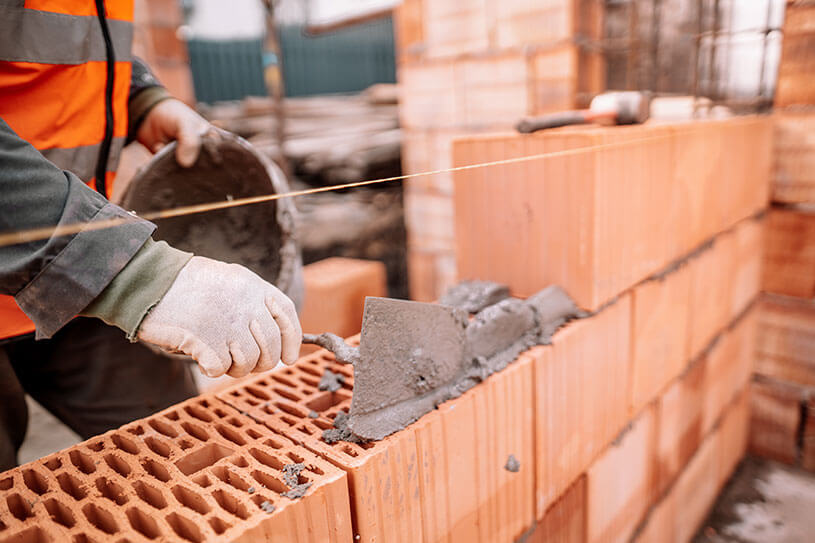If you’re looking to become your own boss, bricklaying is a great option. Tradesman wages are skyrocketing, and the government has recently announced ambitious new housebuilding targets, suggesting that there’s more work on the way for bricklayers.
Not sure where to start with becoming a bricklayer in the UK? Read our step-by-step guide to get you started.
1. Understand what the job entails. Becoming a bricklayer for the first time? You’ll need to know exactly what to expect on the job.
2. How much could you earn? You’ll need to know how much you can expect to earn as a bricklayer.
3. Get training. You might require some training before starting out. There’s a range of courses available.
4. Think about funding. If you need funding to get your business off the ground, you could investigate government grants.
5. Register for tax. It’s important that you register for tax, National Insurance, and potentially VAT straight away.
6. Get insured. Finally, make absolutely certain that you’re properly insured.
7. Start winning clients. Now that you’re all set up, it’s time to start finding clients!
How to become a bricklayer step-by-step
1. Understand the job
If you’re becoming a bricklayer for the first time, you’ll need to know what the job involves. Bricklaying can entail a number of day-to-day tasks, including measuring work areas, cutting bricks, mixing mortar, laying ‘courses’, and making sure that walls are watertight and weatherproof.
2. How much could you earn?
Average bricklayer salaries vary by year, and can be affected by factors including housebuilding, and general economic sentiment. It’s a good idea to research what other bricklayers in your area are charging, then set your prices accordingly.
There are opportunities to boost your income by expanding into a fully-fledged bricklaying business. If you can act as an outsourcing partner for construction firms, eventually employing other bricklayers, you can build a sustainable busines that could pay significantly more.
3. Intensive bricklaying courses
Many bricklayers learn on the job, but if you’re setting up a freelance bricklaying business you might want to carry out some training first. There’s a range of intensive bricklaying courses available throughout the UK, which generally last around five days. These courses don’t normally result in a formal qualification, but they will give you the skills you need to work.
Depending on the kind of work you’re doing, you might also carry out training for working at height. Remember that if you are working at height, you might need to consider specialist insurance.
4. Funding options for bricklayers
It’s possible you’ll need some initial start-up capital to get your venture off the ground. To find finance, your first port of call could be government grants. One of the most popular of these is the New Enterprise Allowance, which offers you money over the course of a set period for the purpose of starting a business.
Read more in our regularly updated guide to the New Enterprise Allowance.
5. Register for tax
When starting your new bricklaying business, one of your first priorities should be to register for income tax and National Insurance and, if relevant, for VAT.
It’s simple to register, but you need to do it within an allotted timeframe. Read about how to register as self-employed in the UK. Remember that you’ll also need to file an annual Self Assessment tax return. Read our guide to Self Assessment for more information.
You’ll also need to think about VAT. You are legally obliged to register for VAT if your turnover exceeds the VAT threshold, but there are some circumstances in which it might be best to voluntarily register even if your earnings don’t reach that level. For more on that, read our guide to VAT for the self-employed.
6. Get insured
It’s crucial that you have the right insurance for your new bricklaying business. You could start with public liability insurance, which can protect you against claims arising from injury or loss suffered by a member of the public during the course of your work. If you employ anyone in your bricklaying business, you’ll also need employers’ liability insurance – this is usually a legal requirement.
Simply Business offers tailored insurance policies for bricklayers. Compare bricklayers’ insurance quotes.
7. Start winning clients
Now that you’re all set up, it’s time to start getting customers! If you’re starting small, there’s a wide range of channels through which you might win new business. This could be as simple as putting cards up in local businesses or approaching the businesses themselves, along with getting listed in local directories. You should also consider advertising online. Sites like RatedPeople allow tradespeople to list themselves and then bid on work, and can be a valuable way for new bricklayers to win business.
As you grow, you might also consider approaching larger clients such as construction firms or architects, especially those in your local area. Remember that the construction industry is closely interconnected. People talk to each other, and recommendations are important – so you’re only as good as your last job.
Finally, as you start to look for work, make sure that you have an online presence. A simple, portfolio-style website is a must, and these can be built with minimum expense. Check out our free tools for building a business website to get you started.
Insure your trades business
Simply Business offers insurance that covers all kinds of trades, including:
- Builders insurance
- Bricklayers insurance
- Carpet fitter insurance
- Contractor insurance
- Flooring contractors insurance
- Glazier insurance
- Handyman insurance
- Joinery insurance
- Plasterers insurance
- Tilers insurance
Is your profession not listed? When you run a quote, you can select your trade from over 1,000 options.
Are you protecting your tools?
As the UK’s biggest business insurance provider, we know the importance of covering your tools. Why not take a look now and build a quick, tailored tool insurance quote?
Photo: Photo: aboutmomentsimages/stock.adobe.com
